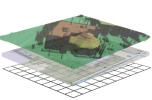History of O'Fallon GIS
 The GIS Group started in 2003 as part of an initiative to modernize the City’s asset management system for Public Works. Along with an inventory of water, storm water, sanitary system, and street information, the City’s first attempt to locate manholes, underground pipe locations, and street features was undertaken. The resulting spatial information was combined with Public Works Computerized Maintenance Management System (CMMS). Over time, the integration of this asset and facility management system became more integrated with GIS features. Within a decade O’Fallon had mapped or collected more than 1 million GIS features.
The GIS Group started in 2003 as part of an initiative to modernize the City’s asset management system for Public Works. Along with an inventory of water, storm water, sanitary system, and street information, the City’s first attempt to locate manholes, underground pipe locations, and street features was undertaken. The resulting spatial information was combined with Public Works Computerized Maintenance Management System (CMMS). Over time, the integration of this asset and facility management system became more integrated with GIS features. Within a decade O’Fallon had mapped or collected more than 1 million GIS features.
Once a foundation of spatial features was established, GIS analysis branched out to helping other departments answer questions relating to geospatial awareness. Projects included a successful electrical tax audit report, several Census boundary studies and population growth analysis, property tax analysis, cemetery records support, and more.
In 2012, the City of O’Fallon was honored with a prestigious Special Achievement in GIS Award (SAG Award) from industry pioneer and software leader, Esri. The SAG Award recipients that year included 170 organizations selected from over 300,000 organizations worldwide that have shown vision, leadership, hard work, and innovation in their use of Esri's geographic information system (GIS) technology.
As expertise with spatial aware data increased, more systems were integrated tightly with GIS. Today, software applications that help route 8,000 Utility Locate calls; allow crews to quickly locate and document sewer camera inspections; integrate Public Safety Dispatch software with accurate address and intersection information; track City vehicles and snow plow call-outs in real time; assist Economic Development and Planning initiatives, and more.
With the advent of online web-based mapping applications, the City’s GIS efforts are reaching out to connect O’Fallon citizens with no-cost mapping solutions, providing up-to-date feature information. The department continues to investigate new ways to bring spatial awareness and powerful geospatial tools to both intradepartmental users and the citizens at large.

